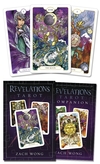Image Evolution: The Revelations Tarot

It is often said that it is the Fool who begins the journey of the Tarot, and much like the Fool, my journey really began when I ran away from home. Well, that is what I often tell my friends in a sensational manner. Instead what this involved was more a journey of self-discovery. During this process of self-discovery, I turned towards the age-old craft of the Tarot, which I had learned in my adolescent years. What I have learned about my life so far is that much like the Tarot, everything often comes full circle in the end.
I bought my first book on Tarot when I was 14, written by Jane Lyle. I was enchanted by a craft that was visually beautiful and rich with symbolism and the fantastical. The blending of the two formed a delicious visual language that intrigued me. As a budding artist, I even attempted to produce my own deck, but quickly abandoned that project when I realized I was merely attempting to copy existing decks.
My love affair with Tarot, however, never died, even though my practice waxed and waned throughout my university years. During this period I explored other decks on the market thanks to the exponential growth of the Internet in the 1990s. Unfortunately, each deck I purchased seemed to give me mixed readings and feelings. Eventually, these decks found their way to my friends as passing gifts leaving me with the standard Rider-Waite.
After graduation, I decided to let go of the purse strings of home and to start my life anew. I found myself traveling lighter and was less burdened by responsibilities of life—freer to fully appreciate the offerings of life. Armed with the Rider-Waite, I decided to further my study of the tarot through explorations on the Internet and such texts as Rachel Pollack's 78 Degrees of Wisdom.
Eventually the frustrated artist within me realized that not only was the Rider-Waite deck not enticing enough to sustain my interest, but limiting in the lack of imagery depicting the reversed meaning. The whole notion of the "reversed meaning" seemed trivialized by the lack of supporting symbolism and imagery. Bred out of necessity, I decided to create my own deck.
Armed with inspirational decks from the Internet, sketches of my own and text that I had accumulated, I began to revisit my understanding of the Tarot through my own interpretations. The line work took me three to six hours on an A4 sketchpad each night after work. It dawned on me by the Empress, that I was indeed the Fool who started on a terribly long journey.
Being a methodical creature, I spent most of my nights over a three-month period completing the Major Arcana. My worst fear, as an artist, was being unable to keep the same style of art throughout all seventy-eight images over any long period of time. There was also a fair bit of challenge in the actuality of the approach—using only a few dots as reference points, I would draw each image with a felt tip pen. Without construction lines in pencil nor real references, each card of the Major Arcana became fluid in development, evolving as the ink stained the page. The theme permeating throughout the Major Arcana was that of "masks," which each character wore. The symbolism of this is derived from mythologies of deities who come to us in human form, often teaching us life’s bigger lessons. Life took over for a while after the first twenty-two cards were completed, and it was a matter of months before I visited the Minor Arcana.
The approach to the Minor Arcana was a little less linear in execution than the Major. I drew whichever card I picked at random from a deck. The irregularity kept the artistic process interesting for most of the way through. Often I kept side notes and sketches of ideas that popped into my head for other cards while drawing another. The Minor Arcana also became a heavier burden and I decided, for my own sanity, to use construction lines in pencil.
The momentum for completing the deck really occurred when I colored my first card on the computer. I picked the ten of Swords, for it was, at the time, one of the first few cards which I found challenging to draw both technically and emotionally. Once I had finished coloring the image, I was stunned at what I had produced. I had found my "voice," as the colors added another layer or richness to the image that the line work had already achieved. I regained the sense of excitement that I had lost over the years. By mid 2002, I had completed about half of the Minor section.
Life, once again, got in the way. A series of disappointments found me turning inwards in the attempt to rediscover myself. I decided then that I would prove my worth to myself. I was a man on a mission, working tirelessly for a month to complete the remaining line work of each card. For the next two months after, all my free time was dedicated to completing the coloring of the deck. I even bought new hardware and equipment and poured my energies into making each card a visual experience in itself. By January 2003, I had a complete deck.
Although it was never my original intention to have the deck published, I decided after making one of my own to see if there were any interested parties. Thankfully, Llewellyn picked up my submission and I have not looked back since. As it would be, one journey's end now begins another.
About Zach Wong
Related Products

is subject to certain Terms and Conditions